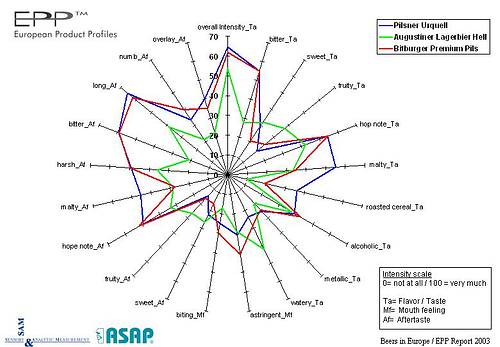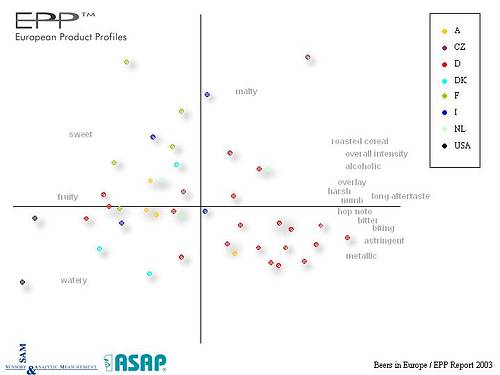Mapping the Taste of Beer
A direct comparison of 60 European beer brands
A German sensory research institute has made a new European survey mapping out various taste characteristics of European beers. With the help of sensory profiles, 60 of the most popular pils, lager, and light beers from 16 different countries can now be directly compared.
Beer is a very popular drink world-wide. There is an almost unlimited number of brands. Europe has about 1660 breweries, of which 1279 are in Germany, the heart land of beer culture. When comparing various sorts of beer, brewers focus primarily on such chemical and physical properties as the percentage of original wort, the amount of alcohol, the degree of fermentation, the ph-level, and the grade of bitterness, colour, etc.
However, the brewers' descriptions of the similarities and differences of various beer tastes is still very subjective and imprecise. Sensory taste profiles can help in clarifying and objectifying these descriptions.
The German Association of Sensory Analysis (ASAP), Munich - a member of the EUROPEAN SENSORY NETWORK - has developed just such a set of profiles. The taste qualities have been analysed by descriptive sensory panels. The panels are groups of testers who have been selected for their sensory and verbal abilities, and then trained to further enhance these skills. As is often the case with descriptive sensory panels, only women were selected for this study. They seem to be better suited than men when it comes to smelling and tasting within scientific testing; it has been shown that women tend to have a higher level of sensory sensibility and are better able to remember and describe their impressions.
The test panel participants first developed a common "beer language", by which they could describe all the sensory qualities of the beers. They agreed on a total of 49 different characteristics. They then graded the intensity of these characteristics in the beers that were tested. Out of the 49 attributes, the 20 that showed the most distinct differences were selected. This individual taste profile can be visualised in the form of a spider-web graphic, and can be immediately compared with the profiles of other beers (see figure 1).

All information concerning the beers' sensory attributes and similarities can be summarised in the form of a map-like graphic, or "biplot" (see figure 2).

For example, one can see that:
there are sharp differences between the Czech Pilsner Urquell (violet dots), which appears the upper right hand corner of the graphic, and all other pils beers in the study. The taste of Pilsner Urquell lies much more in the direction of malt and roasted grain taste.
German pils beers (red dots) tend to have a similar taste, just as their bottles look alike. Almost all the German beers tend towards the direction of hops-like, bitter, pungent and metallic.
Non-German pils such the Danish (turquoise dots) and French (green dots) beers have completely different tastes. Danish beers have a more watery characteristic, while in French beers sweet taste components are predominant.
Bavarian beers (red dots on the left side of the graphic) have a special position in Germany. They are less alcoholic, less tart, less coated, less hops-like etc., and are perceived to have a rather fruity, sweet and watery taste. In some sense they are more "international", as they resemble non-German beers more than they resemble other German brands.
Brewers who wish to introduce a new beer into the market can use such information to help in the planning of marketing strategies. Thus a beer which is to be marketed in Bavaria needs to be designed differently than a beer which is sold in another region of Germany; a French beer will not have the best chance of success in the Danish market unless it conforms to Danish tastes. Which beer tastes best to a particular consumer? How can beers be adapted to the differing tastes in Germany, Italy or France? To answer such questions, data from sensory profiles, consumer studies, and physical and chemical analyses need to be compared. The resulting knowledge can be transformed into recipes that fit the desires of the prospective consumer.
The EPPTM beer study will be continued with other European partners.
Source:
ASAP GmbH, Association for Sensory Analysis and Product Development, Munich, Germany
For additional information, digital picture files or a sample copy please contact the ESN press office.